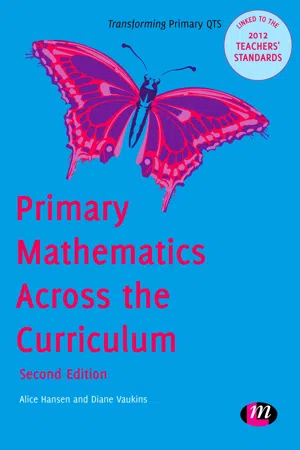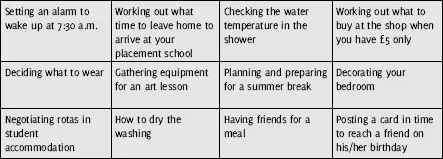![]() PART 1 THE MATHEMATICS CURRICULUM
PART 1 THE MATHEMATICS CURRICULUM![]()
1. Mathematics as a core skill
Learning Outcomes
This chapter explores:
- how mathematics is used in the world around us;
- how we should make links between mathematics and all national curriculum subjects;
- issues relating to planning and assessment;
- the core skills related to using and applying; these are reasoning, problem-solving and communication.
TEACHERS’ STANDARDS
A teacher must:
1. Set high expectations which inspire, motivate and challenge pupils
- establish a safe and stimulating environment for pupils, rooted in mutual respect
- set goals that stretch and challenge pupils of all backgrounds, abilities and dispositions
- demonstrate consistently the positive attitudes, values and behaviour which are expected of pupils.
2. Promote good progress and outcomes by pupils
- plan teaching to build on pupils’ capabilities and prior knowledge
- demonstrate knowledge and understanding of how pupils learn and how this impacts on teaching
- encourage pupils to take a responsible and conscientious attitude to their own work and study.
3. Demonstrate good subject and curriculum knowledge
- have a secure knowledge of the relevant subject(s) and curriculum areas, foster and maintain pupils’ interest in the subject, and address misunderstandings
- demonstrate a critical understanding of developments in the subject and curriculum areas, and promote the value of scholarship
- if teaching early mathematics, demonstrate a clear understanding of appropriate teaching strategies.
4. Plan and teach well structured lessons
- impart knowledge and develop understanding through effective use of lesson time
- promote a love of learning and children’s intellectual curiosity
- contribute to the design and provision of an engaging curriculum within the relevant subject area(s).
5. Adapt teaching to respond to the strengths and needs of all pupils
- have a secure understanding of how a range of factors can inhibit pupils’ ability to learn, and how best to overcome these
- demonstrate an awareness of the physical, social and intellectual development of children, and know how to adapt teaching to support pupils’ education at different stages of development.
Using mathematics in the world around us
Many adults and children hold the perception that mathematics is often something that is ‘done’, rather than something that is used every day as part of our lives and are often unaware of how they use mathematical skills in their everyday tasks.
Activity
To help you think about mathematics as a core skill, below is a list of tasks that you may find yourself undertaking. Choose one or two and identify what mathematical skills you need in order to achieve the desired outcome.
The activity above was designed to encourage you to consider how everyday tasks require a number of mathematical skills. For example, a deceptively simple task in deciding what to wear will include:
- identifying the current and forecast weather (temperature, wet/dry, sunny/cloudy);
- considering the day’s activity (is it fit for purpose: work, pleasure, method of travel);
- the length of your activity/day (the passing of time and telling time);
- choice from the available wardrobe (combinations);
- aesthetic considerations (does it look appealing, pattern, colour).
How did you get on with the task? If you found it difficult to think about the numerous skills that were used and applied in the tasks above, perhaps this helps you to realise that you could be one of the many people who do not relate mathematics to the everyday tasks that you carry out.
It could be argued that you are able to function and carry out these tasks without the mathematical knowledge underpinning the activity. However, teachers are required to assess children’s mathematical ability across the curriculum and not only within a mathematics lesson. Therefore, unless you are able to identify mathematics within everyday activities, your planning, teaching and assessment are likely to be very narrow in their approach to mathematics. Indeed, you may overlook evidence of a child’s mathematical attainment in other parts of the school day.
Recognising and appreciating mathematics
Recognising mathematics in all subjects
Read the following case study and consider what learning opportunities the children were missing out on because of the way that Tamsin approached the two lessons in a discrete (unconnected) manner.
Case Study: Making links between lessons
Tamsin is a trainee teacher working with a Year 5/6 class. She is following the teacher’s medium-term planning for the four-week duration of her placement.
In the morning Tamsin teaches a mathematics transformation lesson focusing on translation, reflection and rotation. Later that day, she is observed teaching a design and technology lesson where the children analyse wallpaper samples and discuss how the pattern was created.
During feedback, her mentor, Phil, comments on how he was surprised Tamsin did not model any mathematical language related to transformation. He also notes that only a small group of children were able to refer to the work they had been doing in their mathematics lesson during their afternoon work.
After some discussion it becomes apparent to both Phil and Tamsin that she did not make the connection between the two lessons herself. They talk about how she will address this in the future through careful planning and improved subject knowledge, as well as how an important aspect of her role is to model mathematical language across all subjects.
In order to address today’s revelation, she decides that the children will be involved in making a display of their own wallpaper creations showing the mathematics they used in order to create the design.
Links to the National Curriculum
The mathematics objectives that Tamsin had in mind during her unit of work were that the children would be able to visualise and describe movements using appropriate language (Ma3, 3a) and transform objects in practical situations … visualise and predict the position of a shape following a rotation, reflection or translation (Ma3, 3b). In design and technology the children were developing, planning and communicating ideas,
specifically developing ideas and explaining them clearly (D&T 1b), planning (D&T 1c), and communicating design ideas in different ways (D&T 1d).
What Tamsin had omitted to see was that the children should have been using appropriate vocabulary in both lessons. The key skills (DfE, 1999, page 20) are embedded throughout the programmes of study in the National Curriculum. The key skills particularly practised in this case study should have been communication and problem-solving. Furthermore, the thinking skill (page 22) (helping with the ‘knowing how’ rather than simply the ‘knowing what’) that should have been most prominent in this case study is reasoning. Crucially, the children using precise language to explain what they are thinking (page 22) during communication will support effective reasoning. This will be discussed in more depth later in this chapter.
Activity
In light of the case study and the introduction of this chapter, why was it important that Tamsin should be able to recognise the connection between her mathematics and design and technology lessons?
Why is it important for all teachers to be able to recognise mathematics in all subjects and parts of the school day?
It is essential that you are able to recognise when mathematics is being used as a tool to learn other curriculum subjects. The above case study and explanation of National Curriculum links demonstrates how Tamsin’s teaching would have more effectively supported the children’s learning if she had seen the links between the morning’s mathematics lesson and the content of the design and technology lesson in the afternoon.
External drivers for appreciating mathematical links
Planning and timetabling
By carefully planning learning experiences that are explicitly linked, it is possible to:
- cover a substantial number of curriculum objectives in a shorter period of time;
- make explicit the links across the artificial subject divisions that the curriculum creates;
- encourage children to use and apply mathematical skills in a range of meaningful contexts;
- approach tasks flexibly using a mathematician’s disposition.
You can read more about the pedagogical reasons for cross-curricular approaches to teaching as well as how timetable constraints also often pragmatically require integrated approaches to learning in Chapter 6, but ultimately, it should be every teacher’s aim for children to recognise and appreciate mathematics in the world around us.
As you are a trainee teacher, you may sometimes find difficulty in making links, as Tamsin did in the case study. Without being involved in the longer-term planning, what is obvious during curriculum development may not be so clear to you as a trainee teacher working from and adapting already established plans. This is specifically why you are encouraged to ‘make planning your own’ and discuss ideas with your mentor in school.
Activity
When you are next on placement, talk to your class teacher, mentor, the mathematics subject leader or mathematics specialist teacher about how they plan for cross-curricular links between mathematics and other subjects.
If possible, ask to see how their planning in the longer term develops, and discuss with them the process that their planning follows to consider cross-curricular links.
Assessing mathematics
In addition to using cross-curricular teaching methods to respond to planning and timetabling constraints, it is also possible to draw on evidence from a wider range of sources in order to assess children’s mathematical attainment. The case study below demonstrates how a trainee teacher was encouraged to use Assessing Pupil Progress (APP) mathematics grids to assess a focus child’s progress, and think about drawing on the wider evidence they had to make decisions about the child’s level of attainment. To access the full APP grids for mathematics, go to www.tes.co.uk/teaching-resource/APP-Level-1-5-Grids-for-Maths-Writing-Reading-6018239/
Case Study: Using assessment evidence from beyond the mathematics lesson
The following transcript is taken from a mentor/trainee discussion about how the trainee, Gurjit, is getting on with his set placement task about using Assessing Pupil Progress (APP) grids in mathematics. Pauline, his mentor, is helping Gurjit to consider evidence beyond that collected during mathematics lessons. Gurjit is placed in a Year 2 class and they are discussing Harry’s attainment.
Pauline: So tell me how you are getting on with Harry’s attainment record.
Gurjit: I have had a go now at completing the maths APP grid, thinking about the lessons that you and I have taught since I arrived.
Pauline: Great. Of course as we discussed last time, it is important to remember that you won’t see evidence pertaining to all the bullets in the grid over your six-week placement because the APP grids should be used over a longer period.
Gurjit: Yes.
Pauline: So let’s have a look at what you have here. Oh, I see that you have not been able to highlight anything about problem-solving?
Gurjit: That’s right. I have realised that I haven’t planned for a lot of problem-solving in my lessons yet. I also have realised that I have not really been focusing on Ma1 – using and applying – at all in my lessons. That is so embarrassing!
Pauline: OK, it is good that you have picked that up, and you have actually come to a realisation that a lot of teachers in school also came to when they started usin...

